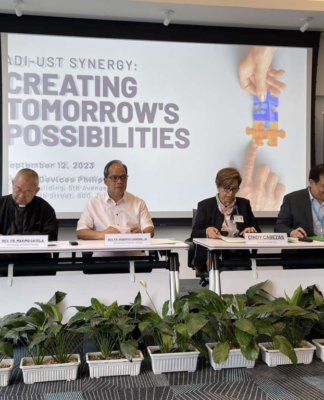A STUDENT from the College of Science received the second Best Project of the Year Award in the annual Bank of the Philippine Islands-Department of Science and Technology (BPI-DOST) awards last Feb. 8 at the Thomas Aquinas Research Complex.
BS Biology senior Kevin Ang bagged the second prize with his research project, “The Development of an Immunoassay for the Environmental Detection and Monitoring of Blo t 5 Allergen in House Dust.” Alex Dy and Paulo Urizza of University of the Philippines – Diliman got the first and third prizes, respectively.
Criteria in the award were quality, relevance and research innovation.
Ang developed a biochemical test that can detect and monitor the presence of Blo t 5, an allergen that triggers human allergy, in house dust.
According to the study, Blo t 5 allergen is the most potent and dangerous among all the eight allergens.
“Biochemical test are useful in allergen avoidance, considered by doctors as the most recommended method of allergy treatment,” Ang said.
Meanwhile, Ang and UST Chemical Engineering students Eric Bajana, and Mcrobart de la Peña received on the same day the BPI Science Award for their excellence in specialized fields of Science and Technology, particularly Mathematics, Physics, Engineering, Biology and Computer Science.
The BPI Science Award is given annually to the top three senior students of the following universities: Ateneo de Davao University, Ateneo de Manila University, De La Salle University, SiIliman University, St. Louis University, University of the Philippines (Diliman and Los Baños), University of San Carlos, University of Santo Tomas, and Xavier University.
De la Peña developed concrete products in the form of tiles using non-biodegradble wastes in his study, “Utilization of Waste Polystyrene and Spent Palm Oil in Manufacture of Floor and Wall Tiles.”
His study focused on minimizing solid waste while generating income from it.
Bajana, on the other hand, studied activated carbon (AC), a material usually found from charcoal, in his research, “Optimization of Conditions in the Chemical Activation of Carbon from Rejected Coffee Beans.”
Bajana used coffee bean residues as a source for the production of AC. He said previous studies showed that it is possible to produce sufficient AC from coffee rejects.
“What we did was to optimize a part of the process of activation,” Bajana said, adding that his study would benefit the textile industry and the local coffee farmers. “AC treatment for dye removal is relatively more expensive and so using a low cost material and maximizing its use would be a great help to the industry,” he said. L. J. D. P.


















